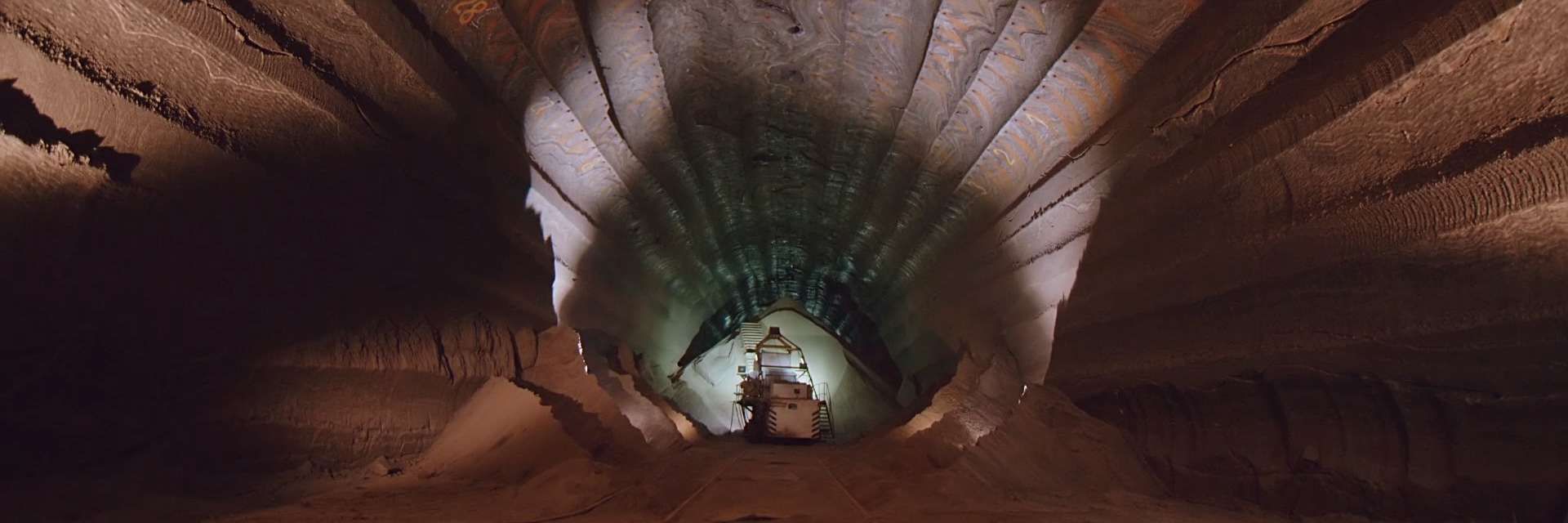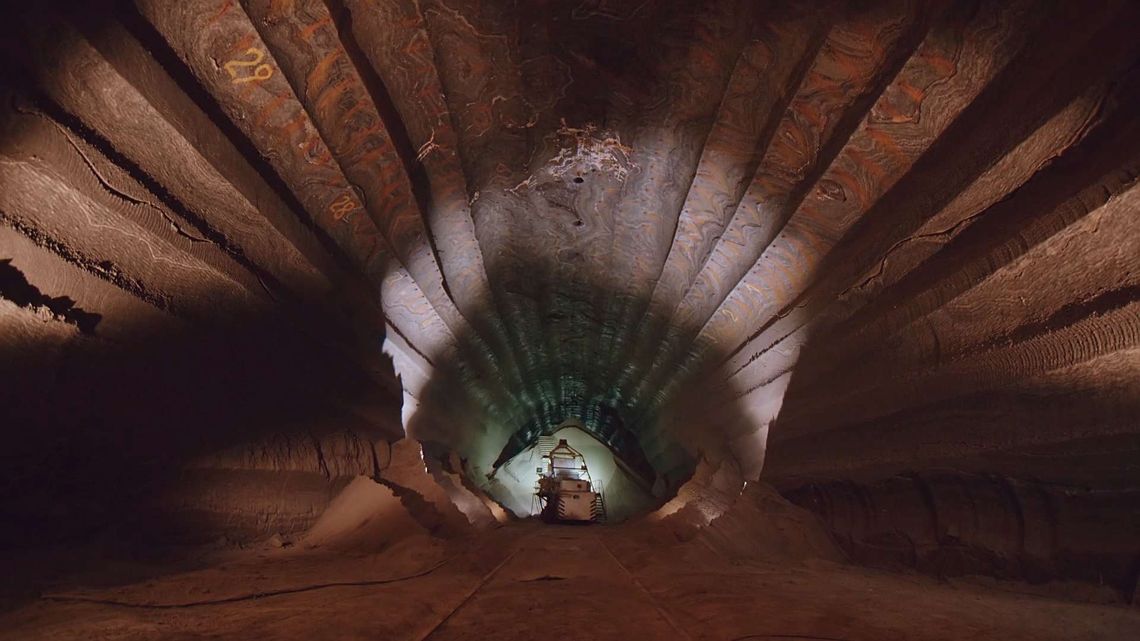
14-03-23
Into the Underland
A conversation with Anika Schwarzlose and Brian D. McKenna about their film UNEARTH
Written by Lena van Tijen
In the run-up to the event LI-MA Presents: A Grain of Sand in the Mountain’s Bell | a collaboration with ReCNTR X ArteEast, taking place on March 28th 2023 at LAB111, writer and translator Lena van Tijen met Anika Schwarzlose and Brian D McKenna in their studio for an in-depth talk about their film UNEARTH.
The first thing artists Anika Schwarzlose and Brian D. McKenna do as we sit down to talk in their studio in Amsterdam is tell me an old Russian Folktale. A green leatherbound book lays beside them on the table with the text The Malachite Casket by P. Bazhov printed on its cover. McKenna opens the book to show me an illustration of a fairylike figure wearing a crown decorated with stones and a dress the color of malachite. Schwarzlose tells me that the creature is the Malachite Maid – also known as the Mistress of the Copper Mountain. A trickster who, in a tale named The Stone Flower, abducts craftsman Danilo into her mountain. After the Malachite Maid shows Danilo the secrets to ultimate craftsmanship, she sets him free. But, he remains forever burdened by the existence of perfection, a state he will never be able to reach.
In their film UNEARTH, Schwarzlose and McKenna also guide viewers into a mountain. Or, more precisely, they take them into mines and to pink terricones (slag heaps that have become artificial volcanos), all located in the Ural region in Russia. Instead of luring the audience with tricks, the artists use eerie sci-fi music and voices to pull them in.
The voices belong to: a writer who grew up in a mining town, two geologists, and a spokesperson for a company that develops AI and IoT for mining technology. Inside the mountain, the viewers do not find the secret to ultimate craftsmanship, but minerals morphing into machines and machines morphing into minerals. An encounter that leaves them wondering about the precise moment at which the human and the non-human collide.

Lena van Tijen (LvT) Anika, in an interview you did for a previous exhibition, I noticed you mentioned that archival footage played an important role in this project. How did looking at images from the past lead you to make a film that feels so futuristic?
Anika Schwarzlose (AS) A big part of the footage we used was not intended for public dissemination. It was made during a promotional campaign a mining company was undertaking. The crew that this company hired produced a lot of luscious, beautiful material that was mostly shot above ground. Such as children playing on a playground, a green forest, and people fishing. But they also recorded material underground.
This material turned out to be way to scary for an image-film. The way the machines ate away at rocks like monstrous dragons. This kind of dark apocalyptic imagery was the opposite of what the company was looking for. The format of the Ural Industrial biennial [the context in which this footage was obtained] is very interesting; it is a biennial that brings contemporary art into contact with industry.
There is a very tacit openness. The industry is trying to open some of its practices to artists, the artists are trying to be as critical as they can without being censored. It is a delicate dance. In the course of this relationship, a mining company opened their archive to us. In the beginning, I thought they’d made a mistake. On the servers, we saw this enormous amount of footage. We thought: we download everything now, just in case this is a misunderstanding. But it turned out they did not mind us using it.
Brian D. McKenna (BDMK) Yes, they had completed their PR films, and for us it felt like something of a moral obligation to make use of all this otherworldly – science fiction-esque footage they had produced. In combination with our own footage and musical atmospheres, we began to explore these otherworldly environments as a kind of psychological idea – a kind of underworld / sub-conscious archetype.
LvT What I found interesting about the film is that the technology, the mining machines that are used to overturn the landscape, mimic the landscape itself. Why do you think that is?
AS I believe that when engineers and developers grow up in the region in which they work, they adapt to its aesthetic vocabulary. Landscape and technology are intertwined; when a mine is exhausted, machines are left underground because it is too expensive to pull them back up again.
Those machines corrode and transform. In turn, metal turns into oxides and salts grow on the machine parts, new connections are formed. You could say they become ‘techno fossils’. Machines become part of the earth’s geology. Thinking about such transmutational processes can help us understand the interconnected relationships between our species with our environments and the technology which we release into those environments.
LvT In a way what you are describing is a romanticist idea: only nature can master itself.
BDMK I like to think about it as hierarchies of exploitation. We have this mindset of taming or dominating nature but we are nature. So actually, we create a system to dominate ourselves.
AS Contemporary industrial mining is making tremendous efforts to obscure the connection between humans and environments. The industry jargon is centered around virtuality and remoteness: it is all about removing human contact.
BDMK This is a kind of ‘digital patina’ that gets glossed over everything.
LvT In my opinion, what you call digital patina gets used by the mining business to create a false sense of security. Don’t you think it is strange that humans don’t feel safe when they look at nature but they do when they look at technology?
BDMK They think they are transcending the body. Becoming pure spirit. In a kind of Descartian split of mind over matter.
AS Being face-to-face with these elements is extremely humbling. It is not a favorable position if you want to tell yourself that you are in control.
LvT The landscape you are presenting is very dystopian but also very beautiful.
AS There is a hypnotic quality to minerals. The mineral has a draw on us, it has a force on the human mind.
BDMK When you deal with industrial scale mining as a subject, it can be tempting to exclusively focus on the exploitative aspects – and to appear as moralising. Beyond aspects of violence or brutality, we wanted to explore the fascination with stones – of disappearing into a world of fantasy or obsession.
LvT So, how did you deal with the moral aspect of mining?
BDMK First there was a fundamental question: either we do mining or we don’t. I think it is very hypocritical to be blanket critical of mining and all the mess, while at the same time buying a new smartphone. There is a confrontation between what we think we want, what we tell ourselves we want, and the realities of obtaining it.
AS Our species has forged a tradition of mining. It won’t be easy to just give that up overnight. Personally, there is no question for me that I condemn environmental destruction. But we did not want to make a film that is only concerned with positioning itself on the “right side” of the discourse. For us, it was important to present the issue in its complexity. I think the first step to improving things, to learn from our situation, is to try and understand it in all its intertwinement.
LvT Is this why you use different voiceovers in your film?
AS Exactly. We felt that the situation in the region is so complex that we cannot do it justice by only voicing our own opinions. The way that the film is made came out of the struggle of not wanting to assume a singular narrative authority.
BDMK We ended up with this ambiguity. Is it mineral, or is it human? Is this technology or is it nature? Is it exploitation or is it a partnership? I think we created an atmosphere in which these questions can be asked.
LvT Your film is the product of ongoing research in the Ural region. How has this research been complicated by the War in Ukraine?
AS It has been brought to a halt. We worked there for years. Now there is an absolute rupture.
BDMK They are faced either with self-censorship or outright censorship.
AS The position people are in was precarious when we started working there [six or seven years ago] and has become close to impossible. I would love to add more chapters to this film but time will have to tell in what way that is possible.
///
At its core, UNEARTH aims at dissolving dichotomies. It invites viewers to see things in an interconnected way. And it enables them to visit a dark underworld, to see the grain of sand in the mountain’s belly. At the end of our conversation, Schwarzlose mentions a quote from Underland by Robert McFarlane: ‘Into the underland, we have long placed that which we fear and wish to lose, and that which we love and wish to save.’ It is precisely this ambiguous realm the artists allow you to enter in their film.
Join LI-MA presents on March 28, 2023 @LAB111
Got curious and want to see UNEARTH and meet the two artists? Check the agenda item LI-MA Presents: A Grain of Sand in the Mountain’s Bell | a collaboration with ReCNTR X ArteEast and get your ticket(s). Next to Anika and Brian you will discover work from Jumana Emil Abboud, Marie-Rose Osta, Basim Magdy and Giovanni Giaretta.

